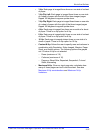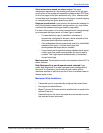
FreeFlow Process Manager Operator and Administrator Guide
2-101
Workflow Builder
Limitations for Imposition and PREPS
• If more than one Impose node exists in a workflow – for
example, workflows with Conditional branches and\or fail
branches with Impose nodes in more than one branch – the
propagation code selects the impose node on the top branch
(or the main branch in case of fail branches) as the "first"
impose node and propagates it with information from the
ticket. If the job takes the second branch during the execution,
the impose node on the second branch, although technically
the “first" impose node to be encountered by the job, will not
contain the ticket information.
• JDF imposition parameters cannot be translated into Preps
imposition templates, and Preps does not support JDF.
• Non-printable content such as bookmarks, sounds, movies,
logical structure, hyperlinks, and article threads will not be
preserved by the Preps imposition component.
• No support for imposition marks such as exposure keys will be
provided within the Xerox imposition templates. Such items
are typically placed in the “gutter” area of the press sheet. This
type of advanced feature is available in Kodak Preps.
• VI Containers should not be used with PREPS. Process
Manager handles these as containers, not PDF files.
• When you submit a job to a Process Manager workflow that
includes Imposition with PREPS, ensure that the PREPS
application is not running if the license is only for one instance
of PREPS.
Fault handling for Imposition
Errors are logged in the Windows Event log and display in the
Workflow Job Manager status display area. The following errors
cause the Imposition operation to fail:
• If the input PDF file is missing.
• If the input PDF file is invalid.
• If the output PDF file is locked and cannot be overwritten or if
the user lacks sufficient security privileges to access the
destination directory.
• If the input PDF file requires a password to open the PDF or
does not permit any of the following: content copying and
extraction, document assembly, or content accessibility.


















